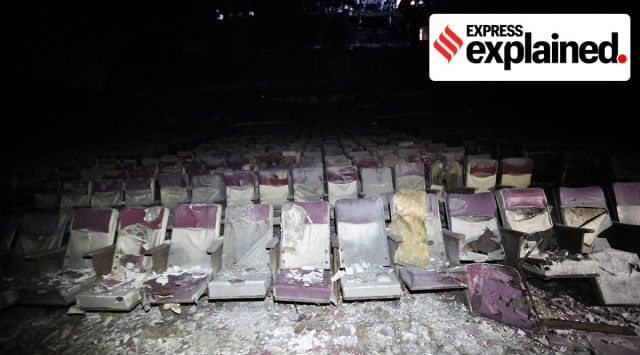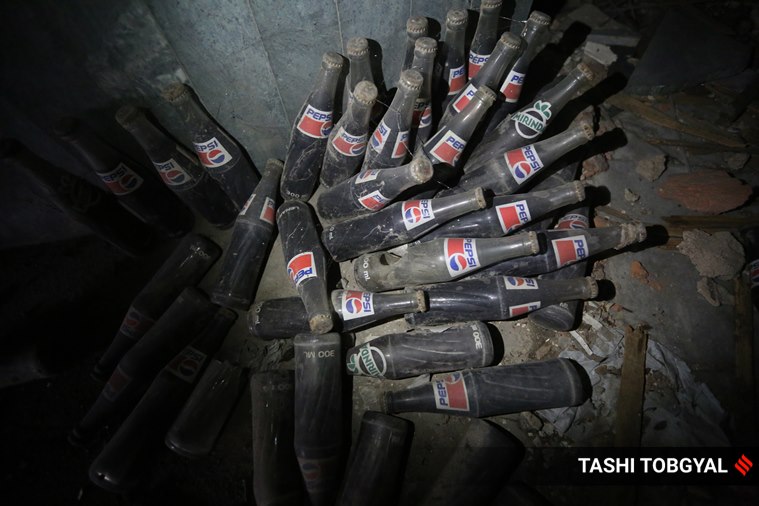Trial by Fire on Netflix: What was the Uphaar Cinema tragedy?
As Trial by Fire, a show based on the Uphaar Cinema tragedy of 1997, is released on Netflix, a look at the calamitous event and the subsequent legal case.
 The interiors of the Uphaar Cinema Hall near Green Park in New Delhi. (Express Photo: Tashi Tobgyal)
The interiors of the Uphaar Cinema Hall near Green Park in New Delhi. (Express Photo: Tashi Tobgyal) On June 13, 1997, during a screening of J P Dutta’s Border, a massive fire broke out at Uphaar Cinema in Delhi’s Green Park. A total of 59 people died of asphyxiation after being trapped in the hall, while 103 were seriously injured in an ensuing stampede to escape.
Subsequently, victims and the families of the deceased formed The Association of Victims of Uphaar Fire Tragedy (AVUT) and filed for damages. What followed was a protracted legal battle which tried to hold the owners of the theatre accountable.
On January 13, Netflix released a mini-series “Trial by Fire”, based on the synonymous book published in 2016. The show recounts the events of the tragedy as well as the following legal battle, from the perspective of Neelam and Shekhar Krishnamoorthy, the parents of two children lost in the fire.
The Indian Express looks back at the tragic incident and the bitter fight for justice that followed.
Uphaar Cinema fire: Here’s what happened
Early morning on that ill-fated day, the larger of the two transformers installed on the ground floor of the Uphaar Cinema building caught fire. While this fire was put out quickly, it damaged the transformer. To get it up and running before the movie hall began operations, quick repairs were carried out. The shoddiness of these repairs was reportedly behind the much larger fire later in the day.
 The interiors of the Uphaar Cinema Hall remain the same since the incident on June 13, 1997. (Express Photo: Tashi Tobgyal)
The interiors of the Uphaar Cinema Hall remain the same since the incident on June 13, 1997. (Express Photo: Tashi Tobgyal)
At around 5 pm, the transformer caught fire again, after one of the repaired cables came loose and caused intense sparking. Since the transformer did not have an oil soak pit, as required under regulations, the burning oil spread outside. Thus, cars parked even at a distance of no more than a metre from the door of the transformer were also engulfed in the flames. By now, the blaze had gone out of control. Thick smoke shot upwards.
Trapped Uphaar Cinema movie-goers struggle to escape
While the fire itself need not have been a death-knell for so many, the cinema was woefully unprepared for such a situation. Smoke entered the cinema hall and as the theatre lost power, there was complete chaos. While the viewers seated in the lower floor were able to escape, people in the balcony were trapped. A total of 59 people died of asphyxiation. Many were also injured in a stampede.
Crucially, due to traffic, fire tenders took over an hour to reach the spot.
Senior advocate Harish Salve, appearing for the Central Bureau of Investigation (CBI) told the Delhi High Court in 2007, “Safety measures, meant for panic situations, were not in place in the ill-fated theatre… the persons, who were getting financial gains from the operation of the cinema, were criminally liable for the lapses.”
 Dilapidated seats at the Uphaar Cinema. (Express Archive)
Dilapidated seats at the Uphaar Cinema. (Express Archive)
The many lapses that caused the Uphaar Cinema tragedy
First, the generator that caught fire was installed after flouting many norms. Not only did it not have adequate safety features, it was placed in what was being used as a parking lot. This meant the fire could not be easily contained as cars with tanks full of highly inflammable gasoline started catching fire. Further, as the investigation later revealed, the generator had not undergone periodic maintenance as required by law.
Second, as Harish Salve mentioned, the hall had inadequate safety measures and procedures in place. There were no exit lights, foot lights, or emergency lights in the cinema – when the building lost power, the hall became pitch dark. There was also no public announcement system to alert the movie-goers of the fire. In the darkness of the cinema hall, it took a significant while for viewers to even realise there was a massive fire in the building.
Third, many exits were locked and gangways blocked due to the hall making unauthorised extensions to increase seating capacity. There were also various unauthorised businesses being run within the building, occupying spaces that were supposed to be empty.
Uphaar Cinema case: The legal battle
In a lengthy legal battle, the victims and family members of the deceased tried to hold the cinema owners liable. The initial chargesheet filed by the investigating CBI contained the names of 16 accused, including the owners Sushil and Gopal Ansal. However, the trial would be long and protracted, with many twists and turns. The fight for justice goes on even today, with an ongoing case of evidence tampering against the Ansals.
The trial court gave its verdict in 2007, a decade after the tragedy, convicting the Ansal brothers of criminal negligence and slapping a two-year prison sentence, the maximum possible in such a case. A year later, the Delhi High Court upheld the conviction but reduced the sentence to one year.
In the Supreme Court, the case went on for almost a decade. In 2017, the apex court directed that the two brothers pay a fine of ₹30 crore each, which would go towards the construction of a trauma centre. As for their sentences, Sushil Ansal, who has spent a total of five months in prison, was let off without further jail time on account of his age (77) and health complications. Gopal was ordered to serve a year in prison.
Compensation to the kin of the deceased was pegged at ₹10 lakh for those over the age of 20, and ₹7.5 lakh to those below 20 years. Injured persons received ₹1 lakh each.
In a separate case, the brothers were put on trial for evidence tampering. In 2021, a Delhi court sentenced both of them to seven years simple imprisonment for tampering with evidence. The court also imposed a fine of ₹2.5 crore on each of the Ansals. This case is on going; the brothers have appealed against their conviction.
Lack of closure for Uphaar Cinema victims
“We didn’t spend as much time with our children on this Earth as we have seeking justice for their murders. We are serving a living death sentence; it has been 26 years, and it is still on,” Shekhar and Neelam Krishnamoorthy told The Indian Express ahead of the release of the Netflix show that documents the couple’s struggle for justice.
On July 19 last year, Sushil and Gopal Ansal walked out of jail. While noting that nothing could compensate the victims’ families for their loss, the court had, however, stated that the order was based on a consideration for the brothers’ ages.
The judicial process which has dragged on for over two-and-a-half decades has left many involved with a bitter taste. A victims memorial in a park across the cinema reflects this. Quoting Martin Luther King Jr, a wall in the memorial reads: “No, no, we are not satisfied and will not be satisfied until justice rolls down like water and righteousness like a mighty stream.”
- 01
- 02
- 03
- 04
- 05






































